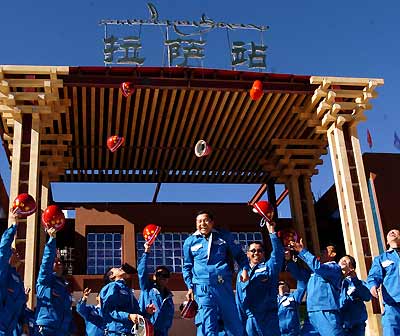| Tools: Save | Print | E-mail | Most Read |
| Lhasa Ready to Receive First Train |
| Adjust font size: |
A stage decorated with flowers and color banners has been built on the square in front of Lhasa Railway Station for a celebration receiving the first train scheduled to arrive Saturday evening. The operation of the history-making Qinghai-Tibet Railway is slated for Saturday morning. It is the first railroad that connects the Tibet Autonomous Region with the other parts of China. The electric screen at the Lhasa station building flashes with slogans, saying "Congratulations on the operation of Qinghai-Tibet Railway." Station workers in this capital of the Tibet Autonomous Region were busy preparing the celebration Friday, one day before the world's highest railroad is put into operation. "The event is an attraction to the whole world. We must get everything ready for it," said Xue Wenjie, a railway station official. A highway between the station and the urban areas has already been completed and opened to traffic. A bus route has been launched on the highway to carry passengers from the railway station to downtown areas. Lhasa Railway Station, with an altitude of 3,600 meters, is located in Doilungdeqen County, southwest of Lhasa, 20 kilometers away from the Potala Palace on the other side of the Lhasa River.
The construction of the railway station started on July 5, 2003 and was completed on June 20. Since the railway will bring more visitors to Tibet, local government has taken measures to better manage tourism activities with the aim to protect cultural and historical relics in Lhasa and other parts in Tibet. Tibet's architectural icon, the Potala Palace, will raise its daily entry quota from 1,500 to 2, 300 as of July 1 when the first passenger train arrives in Lhasa. However, many tourists will still be denied entry despite the increase, according to Nyima Cering, head of the regional department of cultural relics. "A limit on entry is necessary for the protection of the Potala Palace," the official said. First built by the Tibetan King Songtsa Gambo in the 7th century, the Potala Palace was extended during the 17th century by the fifth Dalai Lama, who ruled Tibet in the 13-storey building on the Red Hill, 3,600 meters above sea level. The Potala Palace features the essence of ancient Tibetan architecture and art, and houses countless artifacts. Both the Potala Palace and Norbu Linkag, the summer palace of Dalai Lamas, are on the World Heritage List of the United Nations Educational, Scientific and Cultural Organization (UNESCO). Experts estimate the number of tourist to Tibet will grow by 15- 20 percent year by year after the Qinghai-Tibet Railway opens. A total of 2.5 million tourists will come to Tibet in 2010 and 6 million in 2020. Tourism is only a part of the benefits the railway will bring to Tibet. The railway is expected to give a major boost to local economic and social development. Locals have begun learning new words in the Tibetan language, such as tracks, stations and trains. The vocabulary is expected to describe the historic event when seeing the Qinghai-Tibet Railway starts operations. The region's Tibetan Language Working Committee has published the standard Tibetan word for "train" (megor) and a list of 28 more words and phrases relevant to the railway. According to committee director Cewang Bainjo, the list was drawn up to preserve the purity of the Tibetan language in the face of the expected economic and social boom coming with the trains. Tibetans are already adapting their culture, language and environment in anticipation of the railway's influence on the region's development, said Danba Qoida, another specialist in Tibetan language. "The Qinghai-Tibet Railway will help promote local economic development and improve the living standards of the broad mass of Tibetans, who hope to share in the development of the rest of the country," said Danba. "I like today's Lhasa because I can earn enough to eat and dress well as long as I am diligent and the young people can have a bright future as long as they are eager to learn," said Deji Zhoigar, a 58-year-old woman who operates a snack stand near Bagor Street. "Life will get better as more tourists arrive after the trains start on July 1, which means I have more opportunities to make money," she said. The Qinghai-Tibet railway stretches 1,956 km from Xining, capital of Qinghai Province, to Lhasa. The section of 814 km from Xining to Golmud began operation in 1984 and the Golmud-Lhasa section started construction on June 29, 2001. The railway is the world's highest and longest plateau railroad and also the first railway connecting the Tibet Autonomous Region with the rest of China. (Xinhua News Agency July 1, 2006) |
| Tools: Save | Print | E-mail | Most Read |
 |
| Related Stories |
|
Product Directory China Search |
Country Search Hot Buys |
